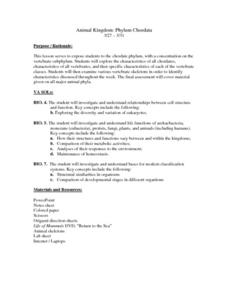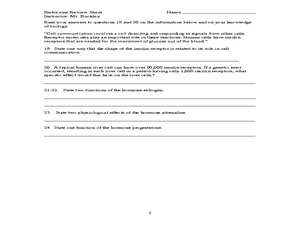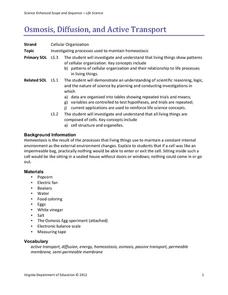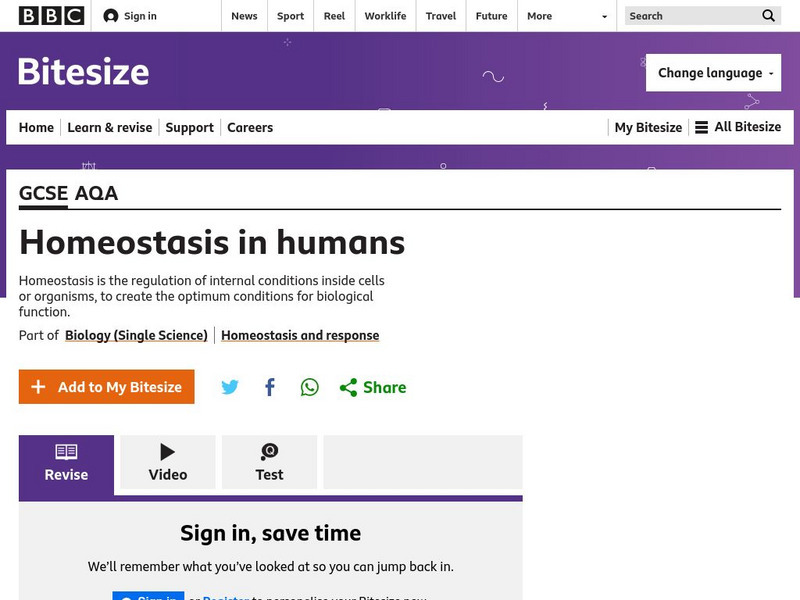Curated OER
Characteristics of Living Things
Seventh graders identify the characteristics of living and non-living things. In this biology lesson, 7th graders define vocabulary words as they go through the lesson. They answer a crossword puzzle after class discussion.
Curated OER
Blood Business
Students identify the different kinds of blood. In this biology lesson, students investigate the antigens, agglutinins and Rh factor using their own blood. They use Punnett squares to predict blood type of offspring.
Curated OER
Human Body Digestion
For this health worksheet, learners find the words that related to the concept of digestion. The answers are found at the bottom of the page.
Curated OER
Animal Kingdom: Phylum Chordata
Young scholars use a dichotomous key to classify various vertebrate jar speciments into classes. They examine the speciments for general characteristics of each class and fill in a corresponding chart and then complete a few final...
Curated OER
The Senses
In this senses worksheet, students use a text book to complete 34 fill in the blank statements about the structures and functions associated with the 5 senses.
Curated OER
Movement, it's FUN-damental!
Learners discover how muscles work. In this biology lesson plan, students explain the causes of fatigue and muscle soreness. They create graphs and compare results with their classmate.
Curated OER
Oxidation Numbers
In this oxidation numbers worksheet, students compare metals and nonmetals, draw Lewis Dot Diagrams, and determine the oxidation number for the given elements. This worksheet has 1 multiple choice, 5 short answer, and 12 fill in the...
Curated OER
Endocrine Review Sheet
Starting with a diagram of the kidneys and urinary tract of the human, this sheet has questions about excretion, blood concentrations of hormones, gland feedback mechanisms and the effects of some hormones.
Serendip
Is Yeast Alive?
Through two investigations, life science learners determine whether or not yeast is alive. They perform tests for metabolism by providing sugar and observing if gas is produced as a byproduct. They incubate some of the sample for at...
Virginia Department of Education
Osmosis, Diffusion, and Active Transport
No, it really is okay to play with your food! Emerging scientists manipulate popcorn, eggs, and other household objects as they demonstrate multiple cellular processes. The activity, capable of modifications, is designed to reflect...
University of Minnesota
What's the Deal? Addiction Card Game
Addiction is a big deal! Playing a game of cards helps learners understand the concept of addiction. Through their analysis, they examine the potential for addiction and how it varies for each individual.
University of Minnesota
Sheep Brain Dissection
Bored with frog and earthworm dissections? Had your fill of fetal pigs? Anatomy students will be intrigued by the sheep's brain, and you will be prepared with guiding questions, extension activities, and pictures as they dissect one —...
Curated OER
Organ Systems
Students examine organisms that are composed of tissues, organs, and systems. They dissect a fetal pig and explore the assigned organs systems such as the skeletal, muscular, and circulatory organs. Students identify and explain their...
University of Minnesota
Virtual Neurons
It's electric! Young anatomists use Virtual Neurons software to build, control, and analyze complex nerve circuits within the body. Colorful and packed with content, class members enjoy interacting with the nervous system...
Curated OER
Teaching the Complexities of Earth's Systems
An understanding of systems is integral to the study of the Earth.
BBC
Bbc: Gcse Bitesize: Homeostasis in Humans
Homeostasis is the regulation of internal conditions inside cells or organisms, to create the optimum conditions for biological function, including body temperature. Links to a video and test are provided.
Georgia Department of Education
Ga Virtual Learning: Biology: Cells
A complete, interactive course where students analyze the nature of the relationships between structures and functions in living cells.
Georgia Department of Education
Ga Virtual Learning: Anatomy and Physiology: Cells
In this module, students discover how each cell is organized to complete the function of producing and transporting proteins, and how cells relate to homeostasis of the body.
Texas Education Agency
Texas Gateway: Cell Homeostasis: Osmosis
Learn how water flows in and out of solutions in this interactive tutorial.
CK-12 Foundation
Ck 12: Life Science: Cell Transport
[Free Registration/Login may be required to access all resource tools.] Cells are found in all different types of environments, and these environments are constantly changing. For example, one-celled organisms, like bacteria, can be...
Concord Consortium
Concord Consortium: Stem Resources: Diffusion, Osmosis, and Active Transport
Have you ever wondered how important gases enter and leave cells? Take an up close tour of a pore in a cell membrane. Then explore diffusion, osmosis, and active transport through this collection of interactive models.
National Institute of Educational Technologies and Teacher Training (Spain)
Ministerio De Educacion: La Formas De Organizacion De La Vida
In this unit you will learn about the origin of the cells and their differences. It includes 15 interactive activities.
McGraw Hill
Glencoe: Biology: The Animal Body and Principles of Regulation Pretest
Students have the opportunity to take this five question pretest to assess their knowledge of the principles of regulation in the human body.
Sophia Learning
Sophia: 7 Characteristics of Life: Lesson 2
This lesson will introduce the 7 characteristics of all living things. It is 2 of 4 in the series titled "7 Characteristics of Life."























